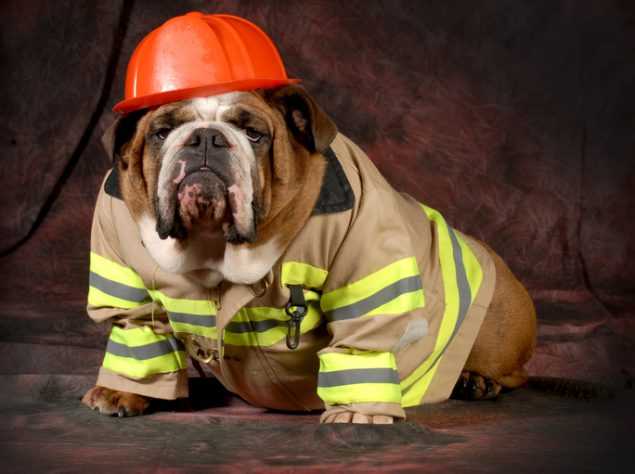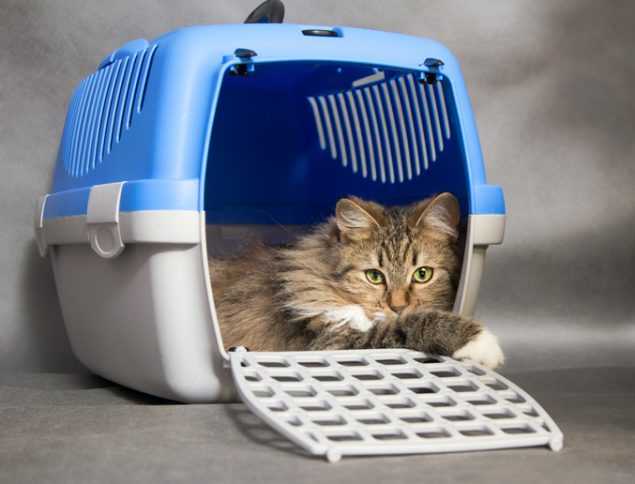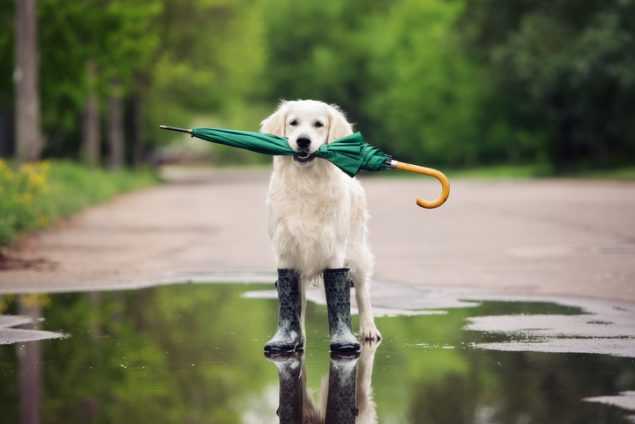Pet Safety in Emergencies

Emergencies come in many forms: fires, hurricanes, earthquakes, tornadoes, floods, violent storms and even terrorism. In the event of extreme weather or a disaster, would you know what to do to protect your pet? Be prepared: make a plan and prepare a disaster kit for your pet. You can find out what type of shelters and assistance are available in your area to accommodate pets. This information can help you include pets in your disaster plan to keep them safe during an emergency.
Before an Emergency
Make a Plan
- Prepare a Pet Disaster Kit so evacuation will go smoothly for your entire family. Ask your veterinarian for help in putting together your pet’s veterinary records.
- Plan where you and your pet will stay in case you need to evacuate your home. Pets may not be allowed in local shelters, unless they are service animals. Many disaster evacuation centers (such as Red Cross evacuation centers) do not accept pets and other animals.
- Create a buddy system in case you’re not home during an emergency. Ask a trusted neighbor who can check on your animals and can evacuate your animals if necessary.
- Locate a veterinarian or animal hospital in the area where you may be seeking temporary shelter and add the veterinarian’s contact information to your emergency kit.
If you don’t have a plan and need information quickly in an emergency, contact:
Local Animal Shelters
Search for local shelters and rescue groups on Petfinder’s Shelter Center. Local animal shelters may be able to offer advice on what to do with your pets if you are asked to evacuate your home.
Local Government
Local government animal control or service agencies can provide guidance on how to protect your pets in an emergency.
Relief Organizations
RedRover shelters and cares for animals displaced by natural disasters and other crises in the United States and Canada. If you need sheltering assistance, please call RedRover at (800) 440-3277 or visit RedRover.org.
Providing shelter for your pet during an emergency
- Identify shelters or out-of-town friends or relatives where your pets and other animals can stay.
- Locate boarding facilities or animal hospitals near your evacuation shelter and in the case you are unable to return home right away.
- For public health reasons, many emergency shelters cannot accept pets and other animals. However, American Red Cross allows all service animals in their emergency shelters.
- Have your pet microchipped with up-to-date contact information for you and an emergency contact outside of your immediate area.
- See CDC’s Disaster Preparedness for Your Pet for a list of websites where you can search for pet friendly hotels.
Create an emergency kit for your pet
CDC’s Disaster Preparedness for Your Pet recommends that you pack the following in an emergency kit for your pet:
- Food and water for at least 2 weeks for each pet
- For cats: litter box and litter
- For dogs: plastic bags for poop
- Medications for at least 2 weeks
- Medical records, including record of vaccination for rabies and other diseases, prescription medications, and medical history.
- Sturdy leashes or harnesses
- Carrier or cage
- Microchip number
- Contact information (cell phone, work phone, home phone) of owner and close relative or friends

Practice evacuating your pet
- Know where your pet might hide when stressed or scared.
- For cats, you can practice removing your cat from his/her hiding spot and using your cat’s carrier, a pillowcase, a sturdy box — anything to get your cat quickly out of harm’s way.
- Train your pets to be in their carriers by making it a comfortable place. Have your entire family practice evacuating with your pets so everyone knows what to take, where to find the pets, and where to meet.
During an Emergencies
Sheltering during an evacuation
- Remember, during a disaster, what is good for you is good for your pet. If you leave your pets behind, they may be lost, injured – or worse. Never leave a pet chained outdoors.
- Contact your local emergency management office and ask if they offer accommodations for owners and their pets. If accommodations are needed for your pet(s): Contact local veterinary clinics, boarding facilities, local animal shelters, family or friends outside the evacuation area, or a pet-friendly hotel, particularly along evacuation routes. Visit the Humane Society website to find a shelter in your area.
- Remember to take your pet’s emergency kit with you.
Sheltering in place
When sheltering at home with your pet, make sure the room chosen is pet-friendly in the following ways:
- Select a safe room, preferably an interior room with no (or few) windows.
- Remove any toxic chemicals or plants.
- Close off small areas where frightened cats could get stuck in (such as vents or beneath heavy furniture).
Diseases the can spread between pets and people during a natural disaster
Natural disasters can contribute to the transmission of some diseases. Exposure to inclement weather conditions, stagnant water, wildlife or unfamiliar animals, and overcrowding can put your pet at risk for getting sick. Some of these illnesses can be transmitted between pets and people (also known as zoonotic diseases or zoonoses). Some common disaster-related diseases that pets can pass to people are the following: rabies, leptospirosis, and diseases spread by mosquitoes, fleas, and ticks.

- Rabies is a virus that affects the nervous system in both animals and people. Rabies is transmitted through bites from rabid animals or through contact with their saliva. To protect you and your pet: Report any bite wounds to medical personnel immediately. Practice safe handling of pets in a stressful situation. Keep your pet in a carrier or on a leash. Do not allow your pet to interact with other animals
- Leptospirosis is a bacterial disease found in the urine of infected animals that can cause kidney damage and affect other organs. It is transmitted through contact with infected urine or contaminated water, soil, and food. Wash your hands after coming in contact with urine. Avoid stagnant water, especially after flooding occurring after natural disasters. Don’t allow pets to play in or drink contaminated water.
- Diseases spread by mosquitoes, fleas, and ticks: Mosquitoes, fleas, and ticks are common pests of stray animals and can be a problem immediately following a disaster situation. Their bites irritate the skin and may also spread a variety of diseases (Lyme disease, West Nile virus) harmful to both people and animals. To help prevent illnesses associated with mosquitoes, fleas, and ticks: Keep your pet away from wildlife and stray animals. Talk to your veterinarian about the use of a regular preventative treatment for fleas, ticks, and parasites for your pet.
Visit Healthy Pets Healthy People for more information on diseases that can spread between animals and people.
Getting separated from a pet
- Make sure that your family is in a safe location before you begin your search.
- If you are in a shelter that houses pets, inform one of the pet caretakers. Give the pet caretaker your pre-made missing pet handout.
- Once you have been cleared to leave the shelter and return home, contact animal control about your lost pet.
- Last, call the microchip company to make sure all the information about your pet including your current contact information is updated and current.
Pet first aid
- Emergency treatment and first aid for pets should never be used as a substitute for veterinary care. But, it may save your pet’s life before you can get your pet to a veterinarian.
- The American Veterinary Medical Association offers specific advice for basic first aid in the case of poisoning, seizures, fractures, external and internal bleeding, burns, choking, heatstroke, and what to do if your pet has no heartbeat or is not breathing.

Tips for handling injured pets
- Never assume that even the gentlest pet will not bite or scratch if injured.
- Pain and fear can make animals unpredictable or even dangerous.
- Don’t attempt to hug an injured pet, and always keep your face away from its mouth, which might scare the animal more or cause them pain.
- Perform any contact with your pet slowly and gently.
- Stop if your animal becomes more agitated or stressed.
- Try to get your pet to a veterinarian as quickly as possible without risking injury or illness to yourself or your family.
Returning home
- Check your home for sharp objects, spilled chemicals, and exposed wiring to protect your family and your pets from injury.
- The behavior of animals may change dramatically after a flood, flash flood, thunderstorm, or hurricane. Normally quiet and friendly animals may become irritable. Monitor animals closely and only release them in safe and secure environment.
Resources
-
CDC
- Disaster Preparedness for your Pet
- Keep your pets safe in an emergency: 5 things to know
- Pet Disaster Kit Checklist [PDF – 2 pages]
- Pet Boarding Instructions [PDF – 2 pages]
- Missing Pet Flyer Template [Doc – 1 page]
- Protect Your Pets in An Emergency
- Interim Guidelines for Animal Health and Control of Disease Transmission in Pet Shelters
- Disaster Information for Pet Shelters
- Ready Wrigley
-
American Veterinary Medical Association (AVMA)
AMVA offers a variety of resources to assist veterinarians, animal owners, and others interested in the well-being of animals to prepare for animal safety in the event of a disaster. Visit AVMA’s Disaster Preparedness Site -
RedRover
Through its volunteer-driven RedRover Responders (formerly the Emergency Animal Rescue Service or EARS), RedRover shelters and cares for animals displaced by natural disasters and other crises in the United States and Canada. If you need sheltering assistance, please call RedRover at (800) 440-3277. Visit redrover.org. -
Federal Emergency Management Agency (FEMA)
FEMA is the federal agency that leads the effort to prepare the nation for all hazards and effectively manage federal response and recovery efforts following any national incident. Visit ready gov: Caring for Animals - Humane Society of the United States: Making a disaster plan for pets
- Louisiana State University College of Veterinary Medicine: Manual for Animal Shelters during a Disaster
- Page last reviewed: October 13, 2017
- Page last updated: October 17, 2017
- Content source:


 ShareCompartir
ShareCompartir